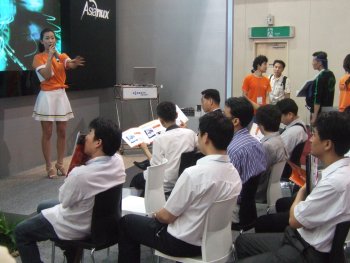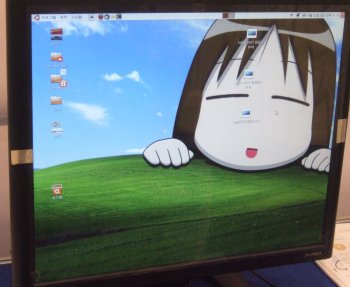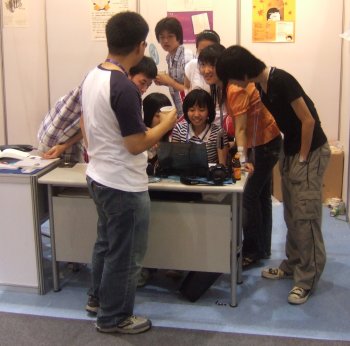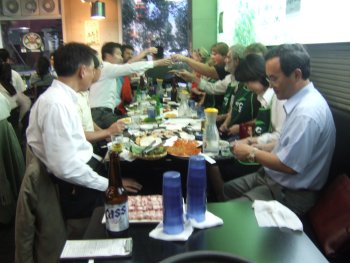Author: Robin 'Roblimo' Miller
SEOUL, SOUTH KOREA — The second annual LinuxWorld Korea took place in Seoul’s Coex Convention and Exhibition Center June 20 through June 23. It was held in conjunction with the annual SEK show, the “representative IT exhibition in Korea.” Some of the companies that routinely exhibit at North American and European Linux-oriented events were there — and so were some you probably never heard of unless you live in or follow IT news from China, Japan, or Korea.
For instance, the biggest single corporate GNU/Linux user in Korea is almost certainly NHN, a company hardly anyone in North America or Europe knows anything about. NHN claims that its Naver search portal gets “nearly 700 million pageviews” daily. The company’s engineering manager (what we’d call their CTO), Paul Kijoon Sung, told me NHN’s income is now approaching $1 billion per year and growing rapidly — as are their Linux-based server farms.
NHN is now testing — Paul says quite successfully — a Hadoop-based distributed file system, and plans to deploy it on a much larger scale soon, starting in Korea, then in Japan, then wherever else they see a market for a Naver-style Internet portal.
NHN is not a Google-scale company (yet?), but it dominates Internet search for Korea’s 70 million citizens, most of whom have access to high-speed Internet connections that shame anything available to US consumers. Japan is a yet larger market, and even there, says Paul, they will not be competing as much against Google as against Yahoo!, which he says is currently Japan’s dominant search portal.
Then there’s Ginux, a “Grid Linux” produced by Seoul-based SK C&C. It had a large booth at LinuxWorld Korea, but I’ve never seen a word about Ginux in any English-language IT publication.
Note that the Ginux Web site is entirely in Korean, with no visible link to an English version. A helpful young man in the company’s booth, Kim Jung Guk, managed to find me an English-language brochure after a little searching. From this brochure I learned that Ginux is based on Booyo, a government-sponsored Korean Linux “reference standard.” A little online searching (Korean gigabyte-per-second Internet access is wonderful!) showed that SK C&C is part of SK, a huge chaebol with interests in businesses ranging from textiles to oil and gas.

Across a show floor aisle from the Ginux display, Haansoft had an even bigger one. Haansoft owns a majority share of ThinkFree, a California-based online office suite company. Haansoft also produces Haansoft Office (formerly Hancom Office), which has had modest success competing against Microsoft Office in Korea. In fact, Haansoft Office supposedly has 70% of the Korean office suite market sewed up, which means it is not only successfully competing against Microsoft in Korea, but whipping Microsoft’s corporate keister here. But it’s doing it modestly, and getting little or no recognition for this stellar success outside of the home country.
Haansoft is also the Korean partner in the CJK effort behind Asianux. The Japanese partner is Miracle Linux, and Red Flag Linux is the Chinese standard-bearer in this effort to produce a version of Linux native to the three big IT powers in East Asia.
References to “CJK” abounded at LinuxWorld Korea. I asked someone what it meant, and he said, “It stands for China, Japan, and Korea. Our countries now work together in software, whatever our other differences, because of our common cultural heritage.”

The person who explained CJK to me was Tae Yeol Kim, director of open source software business promotion for KIPA, the government-run Korean IT Industry Promotion Agency. He also told me his agency is now putting most of its energy into promoting Web-delivered software, not desktop programs; that it believes this is the wave of the computing future and that it is only a matter of time before desktop operating systems and desktop software become unimportant. Meanwhile, KIPA likes Linux; it converted its own desktop computers to Linux in 2004. And even though many people I met at LinuxWorld Korea told me the Korean Linux desktop presence is “negligible,” GNU/Linux seems to be making at least some desktop inroads here, and it is unquestionably the dominant Korean Web server OS. And now KIPA is working to expand Korea’s presence as a worldwide provider of Web-based software services — running on Linux servers, of course.
Embedded Linux is a fast-growing presence in Asian IT
Embedded Linux is becoming a big deal in Korea. And China. And Japan. Ubuntu instigator Mark Shuttleworth was one of the four keynote speakers at LinuxWorld Korea this year, and instead of talking about Linux in general or desktop Linux or even Linux on servers, he spoke about embedded Ubuntu, then sat down for a short private conversation with a Samsung vice president about embedded Linux, then flew off to Guangzhou, China, for yet another set of discussions about embedded Linux at an Open Source China conference. Fellow keynoter Jim Zemlin, executive director of the Linux Foundation, hitched a ride with Shuttleworth on his private jet; he wanted to hit the Guangzhou conference, too.

Shuttleworth obviously believes emebedded Linux is getting big in Asia — and wants to make sure Ubuntu is part of this wave — to the point where he
literally flew from the other side of the world, specifically from DebConf 7 in Edinburgh, Scotland, to spend less than 18 hours in Korea before heading off to China.
The reason embedded Linux is a hotter topic in CJK than in other parts of the world should be obvious: This is where the vast majority of the world’s handheld computing devices are made.
The big shift we’re seeing now isn’t in where the physical hardware is being produced. East Asia has dominated computing device production for several decades now. But what is new is that the hardware is now almost entirely designed here, and the software that runs it is starting to be written here as well. CJK is no longer merely a follower in Linux development, and it’s entirely possible that we will soon see more Linux and open source development in China, Japan, and Korea than in North America or Europe. I sort of predicted this shift back in 2002. Now, five years later, Linux and open source software development in East Asia, especially CJK, and most especially embedded Linux in these countries, is booming.
More about the show itself
This was primarily a commercial trade show. The presentation part was thin compared to many western open source conferences. There were four keynotes. In addition to Shuttleworth and Zemlin, the other two were Simon Phipps, chief open source officer at Sun Microsystems, and (I guess they were scraping the bottom of the barrel) me. You can read more about the keynotes and conference sessions on the show’s Web site.

I spent most of my time looking at the show floor and getting buttonholed by attendees who either wanted to share information with me or ask me questions. As I mentioned at the top of this article, this year LinuxWorld Korea was held in conjunction with a much larger IT show called SEK. In fact, the LinuxWorld section was squished into a comparatively small corner of a huge exhibition hall. Both Samsung and LG had consumer product displays bigger than all the Linux exhibits combined. Those two companies alone had at least 1,000 square feet of big-screen TVs looking down over the scene. An also-ran office software company (at least in Korea) called Microsoft had a robust presence, too, and there were hundreds of other exhibitors large and small, selling hardware and software and cellular phones and wire ties and routers and home automation systems and MP3 players and digital cameras and everything else a modern person or company needs to keep up with the IT Joneses — or Kims, in this case. More than 100,000 people visited. Bo Young Kim, director of TSKG, Inc., the company that organized the LinuxWorld part of the show, told me they had more than 2,000 preregistered conference attendees (far more than they’d had at their first Korean LinuxWorld in 2006), and that by the time the show wound down they’d handed out more than 20,000 free exhibit passes on the spot.

An awful lot of Koreans were exposed to Linux and open source for the first time at this show. Some of them — by my guess, at least 1,000 — stopped by the little row of volunteer-run booths manned and womanned by members of Korean FOSS promotion group KLDP and other GNU/Linux enthusiasts, including members of two Seoul-based Linux users groups. IBM had a (Hyundai) truck painted bright blue, full of servers, that drew a steady stream of black-suited management-looking men interested in IBM’s (Linux-oriented) wares. Hewlett-Packard drew crowds, in part because children were drawn to the many inflatable HP penguins that inhabited its exhibit space. Red Hat Korea had a jumpin’ display, and Haansoft drew mobs, no doubt because everyone was interested in their products, not because they were giving away free soft drinks and had scads of young girls in midriff-baring outfits handing out swag and gathering crowds for their (quite loud) product presentations.
As usual at IT trade shows and conferences, though, much of the “action” was in the form of private meetings both during the show and after hours. I went to two evening gatherings, one of which involved massive drinking in a high-end private karaoke room. I can’t share what went on there with you (even though no sex or nudity was involved) because “what happens in the karaoke room stays in the karaoke room.” But the other gathering, at a nearby traditional kimchi restaurant, along with a number of one-on-one conversations with Korean software developers, open source devotees, and corporate executives started me thinking about the many ways open source development in East Asia differs from open source development elsewhere. More on that after I recover from my l-o-n-g flight home to Florida, USA.
Category:
- Events



